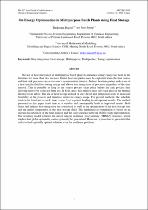JavaScript is disabled for your browser. Some features of this site may not work without it.
- ResearchSpace
- →
- Research Publications/Outputs
- →
- Conference Publications
- →
- View Item
| dc.contributor.author |
Majozi, T

|
|
| dc.contributor.author |
Stamp, J

|
|
| dc.date.accessioned | 2014-08-27T05:54:06Z | |
| dc.date.available | 2014-08-27T05:54:06Z | |
| dc.date.issued | 2010-10 | |
| dc.identifier.citation | Majozi, T and Stamp, J. 2010. On energy optimisation in multipurpose batch plants using heat storage. In: 13th Asia Pacific Confederation of Chemical Engineering Congress (APCChE 2010), Taipei, Taiwan, 5-8 October 2010 | en_US |
| dc.identifier.uri | http://hdl.handle.net/10204/7637 | |
| dc.description | 13th Asia Pacific Confederation of Chemical Engineering Congress (APCChE 2010), Taipei, Taiwan, 5-8 October 2010 | en_US |
| dc.description.abstract | The use of heat integration in multipurpose batch plants to minimise energy usage has been in the literature for more than two decades. Direct heat integration may be exploited when the heat source and heat sink processes are active over a common time interval. Indirect heat integration makes use of a heat transfer fluid for storing energy and allows heat integration of processes regardless of the time interval. This is possible as long as the source process takes place before the sink process thus allowing heat to be stored for later use. In both cases, heat transfer may only take place if the thermal driving forces allow. The use of heat storage instead of only direct heat integration leads to increased flexibility in the process and therefore improved energy usage. For present methods, the schedule tends to be fixed and as such, time is also fixed a priori, leading to sub-optimal results. The method presented in this paper treats time as a variable and consequently leads to improved results. Both direct and indirect heat integration are considered as well as the optimisation of the heat storage size and the initial temperature of the heat storage fluid. The mathematical formulation is based on an uneven discretization of the time horizon and the state sequence network (SSN) recipe representation. The resulting model exhibits the mixed integer nonlinear programming (MINLP) structure, which implies that global optimality cannot generally be guaranteed. However, a procedure is presented that seeks to find a globally optimal solution, even for nonlinear problems. | en_US |
| dc.language.iso | en | en_US |
| dc.relation.ispartofseries | Workflow;5075 | |
| dc.subject | Heat integration | en_US |
| dc.subject | Heat storage | en_US |
| dc.subject | Multipurpose | en_US |
| dc.subject | Multiproduct | en_US |
| dc.subject | Energy optimisation | en_US |
| dc.title | On energy optimisation in multipurpose batch plants using heat storage | en_US |
| dc.type | Conference Presentation | en_US |
| dc.identifier.apacitation | Majozi, T., & Stamp, J. (2010). On energy optimisation in multipurpose batch plants using heat storage. http://hdl.handle.net/10204/7637 | en_ZA |
| dc.identifier.chicagocitation | Majozi, T, and J Stamp. "On energy optimisation in multipurpose batch plants using heat storage." (2010): http://hdl.handle.net/10204/7637 | en_ZA |
| dc.identifier.vancouvercitation | Majozi T, Stamp J, On energy optimisation in multipurpose batch plants using heat storage; 2010. http://hdl.handle.net/10204/7637 . | en_ZA |
| dc.identifier.ris | TY - Conference Presentation AU - Majozi, T AU - Stamp, J AB - The use of heat integration in multipurpose batch plants to minimise energy usage has been in the literature for more than two decades. Direct heat integration may be exploited when the heat source and heat sink processes are active over a common time interval. Indirect heat integration makes use of a heat transfer fluid for storing energy and allows heat integration of processes regardless of the time interval. This is possible as long as the source process takes place before the sink process thus allowing heat to be stored for later use. In both cases, heat transfer may only take place if the thermal driving forces allow. The use of heat storage instead of only direct heat integration leads to increased flexibility in the process and therefore improved energy usage. For present methods, the schedule tends to be fixed and as such, time is also fixed a priori, leading to sub-optimal results. The method presented in this paper treats time as a variable and consequently leads to improved results. Both direct and indirect heat integration are considered as well as the optimisation of the heat storage size and the initial temperature of the heat storage fluid. The mathematical formulation is based on an uneven discretization of the time horizon and the state sequence network (SSN) recipe representation. The resulting model exhibits the mixed integer nonlinear programming (MINLP) structure, which implies that global optimality cannot generally be guaranteed. However, a procedure is presented that seeks to find a globally optimal solution, even for nonlinear problems. DA - 2010-10 DB - ResearchSpace DP - CSIR KW - Heat integration KW - Heat storage KW - Multipurpose KW - Multiproduct KW - Energy optimisation LK - https://researchspace.csir.co.za PY - 2010 T1 - On energy optimisation in multipurpose batch plants using heat storage TI - On energy optimisation in multipurpose batch plants using heat storage UR - http://hdl.handle.net/10204/7637 ER - | en_ZA |






